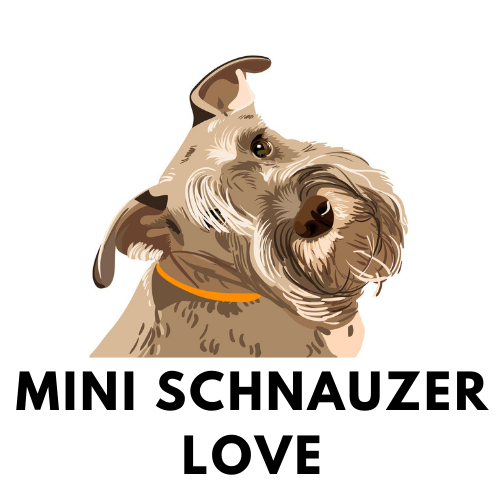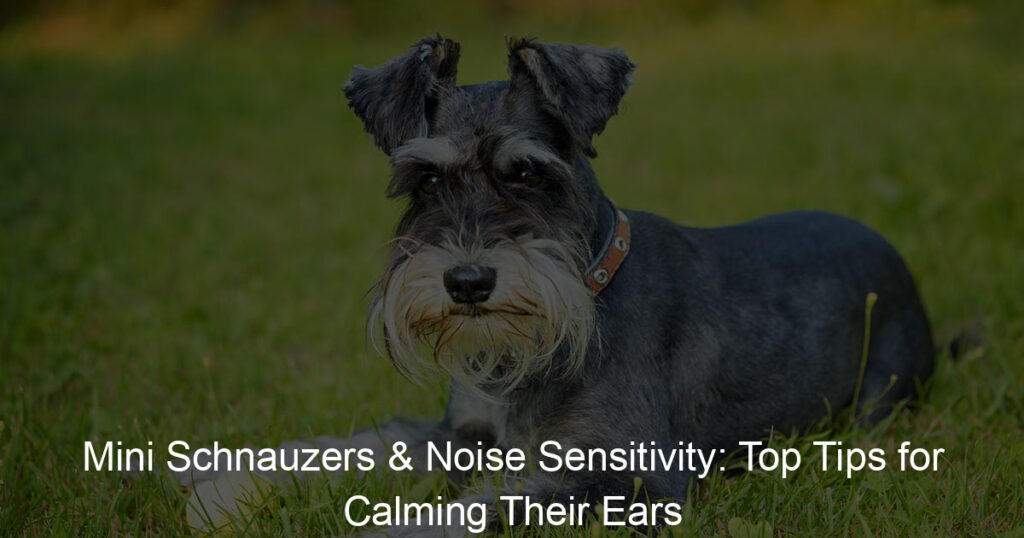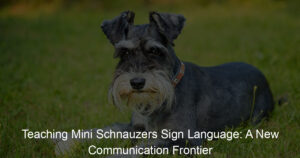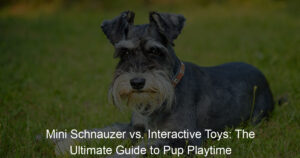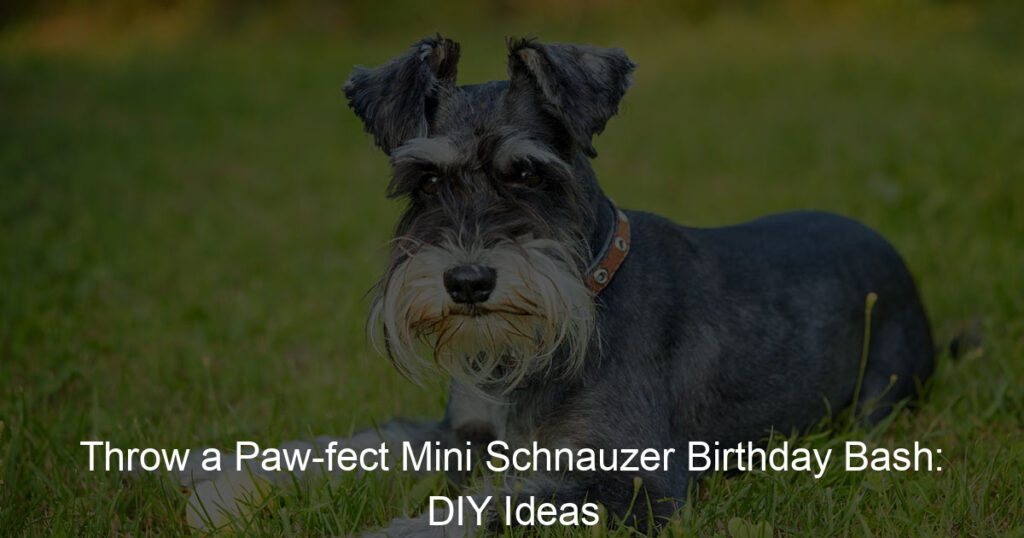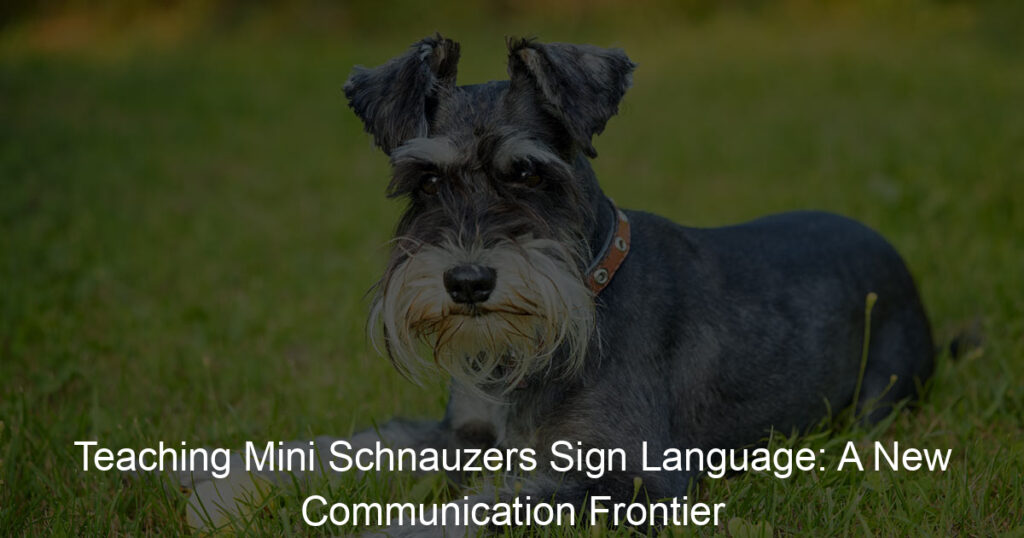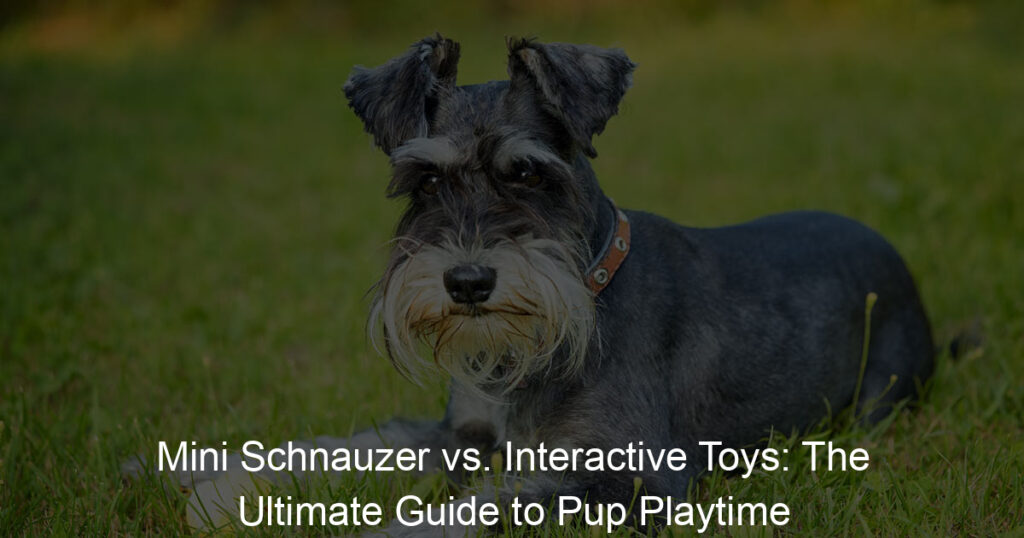
Introduction to Mini Schnauzers and Noise Sensitivity
When it comes to the world of dogs, Mini Schnauzers are a breed that stands out. They are known for their distinctive looks, energetic nature, and a unique sensitivity to noise. This blog post will delve into the specifics of Mini Schnauzers and their noise sensitivity.
- Overview of Mini Schnauzers
- Understanding noise sensitivity in dogs
- Specifics of noise sensitivity in Mini Schnauzers
Mini Schnauzers, short for Miniature Schnauzers, are a small breed of dogs that originated in Germany. They are known for their distinctive beard and eyebrows, as well as their lively and playful nature. Despite their small size, Mini Schnauzers are robust and muscular, with a natural instinct for chasing and hunting. They are also known for their intelligence and versatility, making them a popular choice for families and individuals alike.
Noise sensitivity in dogs is a common issue that many dog owners face. It refers to a dog’s heightened reaction to certain sounds, which can result in fear, anxiety, or even panic. This sensitivity can be triggered by a variety of noises, from thunderstorms and fireworks to everyday household sounds like vacuum cleaners or doorbells. It’s important to note that noise sensitivity can vary greatly from dog to dog, with some dogs showing only mild discomfort while others may exhibit severe anxiety.
When it comes to Mini Schnauzers, their noise sensitivity is often more pronounced. This is due to their acute sense of hearing, which is much more sensitive than that of humans. As a result, sounds that may seem normal to us can be overwhelming for them. Mini Schnauzers may react to these sounds by barking excessively, hiding, or showing signs of anxiety such as panting and pacing. It’s crucial for owners to recognize these signs and take steps to help their Mini Schnauzers feel safe and comfortable.
In the following sections, we will delve deeper into understanding auditory sensitivity in Mini Schnauzers, how to deal with noise-sensitive Mini Schnauzers, and provide tips for calming dogs with noise sensitivity. We will also share some inspiring case studies of Mini Schnauzers overcoming noise sensitivity.
Understanding Auditory Sensitivity in Mini Schnauzers
As a Mini Schnauzer owner, it’s essential to understand your pet’s unique needs and sensitivities. One such sensitivity is auditory sensitivity. Let’s delve deeper into what this means and how it affects your Mini Schnauzer.
What is Auditory Sensitivity?
Auditory sensitivity, also known as noise sensitivity, is a condition where certain sounds cause discomfort or distress. This sensitivity can range from mild to severe, and it’s not just about the volume of the sound. Tone, pitch, and suddenness can all play a part.
- Definition and explanation of auditory sensitivity
- How it affects Mini Schnauzers
Auditory sensitivity is a condition where an individual or animal experiences discomfort or distress due to certain sounds. It’s like having a superpower where you can hear sounds louder or more intensely than others. But, like all superpowers, it can be a blessing and a curse. It can help your Mini Schnauzer pick up sounds that you might miss, but it can also make everyday noises seem unbearably loud.
Mini Schnauzers, like many other dog breeds, have a more acute sense of hearing than humans. This means they can hear sounds that we can’t. But, with auditory sensitivity, this heightened sense of hearing can lead to discomfort or distress. For example, the sound of a vacuum cleaner or a thunderstorm might be just a minor annoyance to us, but to a Mini Schnauzer with auditory sensitivity, it can be terrifying.
Understanding your Mini Schnauzer’s auditory sensitivity is the first step towards helping them cope with it. In the next section, we will discuss the signs of noise sensitivity in Mini Schnauzers and how you can help your furry friend.
Signs of Noise Sensitivity in Mini Schnauzers
Mini Schnauzers, like other dog breeds, can sometimes be sensitive to loud noises. This sensitivity can manifest in various ways, both behaviorally and physically. Recognizing these signs is the first step to helping your pet cope with their sensitivity.
- Behavioral signs
- Hiding or trying to escape
- Pacing or restlessness
- Excessive barking or whining
- Unusual clinginess or seeking comfort
- Physical signs
- Shaking or trembling
- Excessive panting or drooling
- Loss of appetite
- Accidents in the house despite being house trained
Behavioral signs of noise sensitivity in Mini Schnauzers can be quite noticeable. They may display signs of fear or anxiety when exposed to loud noises. This could include behaviors such as:
These behaviors are often a response to the stress caused by the noise. It’s important to remember that each dog is unique, and not all Mini Schnauzers will react in the same way.
Physical signs of noise sensitivity can also be observed in Mini Schnauzers. These can include:
These physical signs are often a result of the anxiety and stress caused by the loud noise. It’s important to monitor your pet closely if they display any of these signs and consult with a vet if necessary.
Understanding the signs of noise sensitivity in your Mini Schnauzer is crucial to their well-being. By recognizing these signs, you can take steps to help your pet cope with their sensitivity and improve their quality of life.
Dealing with Noise Sensitive Mini Schnauzers
For those who have Mini Schnauzers, it’s important to understand that these dogs can be particularly sensitive to noise. This sensitivity can lead to stress and anxiety for your pet. But don’t worry, there are ways to help your Mini Schnauzer cope with noise sensitivity.
Creating a Safe Space for Your Dog
One of the most effective ways to help your noise-sensitive Mini Schnauzer is by creating a safe space for them. This involves two key steps:
- Choosing the right location
- Creating a comfortable environment
When selecting a location for your dog’s safe space, consider a quiet, low-traffic area of your home. This could be a spare room, a corner of your living room, or even a large closet. The goal is to choose a place where your dog can retreat to when they feel overwhelmed by noise.
Once you’ve chosen the right location, it’s time to make it comfortable for your Mini Schnauzer. This could involve adding a cozy bed, a favorite toy, or a blanket that smells like you. You can also consider adding some calming elements like soft lighting or white noise. Remember, the aim is to make this space a sanctuary for your dog where they can feel safe and secure.
By taking these steps, you can help your Mini Schnauzer manage their noise sensitivity. It’s all about understanding their needs and providing them with a supportive environment. Remember, every dog is unique, so it may take some time to figure out what works best for your Mini Schnauzer.
Training Techniques for Noise Sensitive Dogs
When dealing with noise sensitive Mini Schnauzers, it’s important to use effective training techniques. Two of the most successful methods are Desensitization and Counter-conditioning. These techniques can help your dog feel more comfortable and less stressed in noisy environments.
- Desensitization
- Counter-conditioning
Desensitization is a process where you gradually expose your dog to the noise that scares them, but at a very low level. Over time, you slowly increase the volume. The goal is to get your dog used to the noise so that it no longer frightens them.
For example, if your Mini Schnauzer is scared of thunder, you might start by playing a recording of a thunderstorm at a very low volume. As your dog gets used to the sound, you can slowly turn up the volume. It’s important to take this process slowly and be patient. Remember, the goal is to make your dog feel safe and comfortable, not to overwhelm them.
Counter-conditioning is another effective technique. This method involves changing your dog’s emotional response to the noise. Instead of feeling scared, you want your dog to associate the noise with something positive.
For instance, you could give your dog a treat or play a fun game with them every time they hear the scary noise. Over time, your dog will start to associate the noise with these positive experiences, rather than feeling scared.
Both Desensitization and Counter-conditioning can be very effective when used correctly. However, it’s important to remember that every dog is different. What works for one dog might not work for another. It’s always a good idea to consult with a professional dog trainer or a vet if you’re struggling with your dog’s noise sensitivity.
Tips for Calming Dogs with Noise Sensitivity
One of the most effective ways to calm a noise-sensitive Mini Schnauzer is through sound therapy. This method uses different types of sounds to help your dog feel more comfortable and less anxious when exposed to loud noises.
Using Sound Therapy
Sound therapy is a technique that uses sound to create an environment that is calming and soothing for your dog. It can be particularly beneficial for Mini Schnauzers who are sensitive to noise.
- Types of Sound Therapy
- White Noise: This type of sound therapy uses a constant, unchanging sound that helps to mask other noises that might be causing your dog anxiety.
- Classical Music: Studies have shown that classical music can have a calming effect on dogs. The slow, soothing rhythms can help to reduce your dog’s stress levels.
- Nature Sounds: Sounds such as rain, waves, or birdsong can also have a calming effect on dogs. These sounds can help to distract your dog from the noises that are causing them stress.
- Benefits of Sound Therapy for Mini Schnauzers
- Reduced Anxiety: By masking the noises that cause your dog stress, sound therapy can help to reduce their overall levels of anxiety.
- Improved Sleep: The calming effects of sound therapy can also help your dog to sleep better. This can be particularly beneficial if your dog tends to get anxious at night.
- Better Behavior: Dogs who are less anxious are likely to behave better. This means that sound therapy can also have benefits for your dog’s overall behavior.
There are several types of sound therapy that you can use to help your Mini Schnauzer. These include:
Sound therapy can have several benefits for Mini Schnauzers who are sensitive to noise. These include:
Using Calming Products
When dealing with noise sensitivity in Mini Schnauzers, calming products can be a great help. These products are designed to soothe and relax your dog, making them less reactive to loud noises. Let’s explore some of these calming products.
- Calming Wraps
- Calming Sprays
- Calming Treats
Calming wraps are a type of dog anxiety vest that apply gentle, constant pressure to your dog’s body. This pressure can help to reduce anxiety and fear during loud noise events. Think of it as a comforting hug for your Mini Schnauzer.
Calming sprays are another useful tool. These sprays typically contain natural ingredients like essential oils that have a calming effect on dogs. Simply spray it in your dog’s environment or on their bedding to create a more relaxing atmosphere.
Calming treats are special dog treats that contain ingredients known to help reduce anxiety and stress in dogs. These can be given to your Mini Schnauzer before a potentially stressful event, like a thunderstorm or fireworks display.
Remember, every dog is unique and what works for one may not work for another. It’s important to try different products and see what works best for your Mini Schnauzer. Always consult with your vet before introducing any new products into your dog’s routine.
Case Studies: Mini Schnauzers Overcoming Noise Sensitivity
Let’s delve into real-life examples of Mini Schnauzers who have successfully managed their noise sensitivity. These case studies will provide a clearer understanding of how to help your Mini Schnauzer overcome their fear of noises.
-
Case Study 1: Overcoming Fear of Thunderstorms
Meet Max, a three-year-old Mini Schnauzer who used to tremble at the sound of thunderstorms. His owners, the Johnsons, were quite worried about his extreme fear. They decided to take a proactive approach and consulted a professional dog trainer.
They started by playing recorded thunderstorm sounds at a low volume, gradually increasing the volume over time. This method, known as desensitization, helped Max become accustomed to the noise. They also created a safe space for Max where he could hide during thunderstorms. Over time, Max’s fear of thunderstorms significantly reduced.
Key Takeaway: Desensitization and creating a safe space can help Mini Schnauzers overcome their fear of thunderstorms.
-
Case Study 2: Dealing with Sensitivity to Household Noises
Next, we have Bella, a two-year-old Mini Schnauzer who was extremely sensitive to household noises such as the vacuum cleaner and the blender. Bella’s owners, the Smiths, decided to tackle this issue head-on.
They began by introducing Bella to the noise-making objects when they were off. They allowed her to sniff and explore these objects. Then, they would turn on the objects at a low setting, rewarding Bella with treats for calm behavior. This process, known as counter-conditioning, helped Bella associate these noises with positive experiences.
Key Takeaway: Counter-conditioning can help Mini Schnauzers associate household noises with positive experiences, reducing their fear.
These case studies demonstrate that with patience, consistency, and the right techniques, it is possible to help your Mini Schnauzer overcome their noise sensitivity. Remember, every dog is unique and what works for one may not work for another. It’s important to try different methods and see what works best for your furry friend.
Conclusion: Mini Schnauzers and Sensitivity to Sound
In this blog post, we have delved deep into the world of Mini Schnauzers and their sensitivity to sound. We have explored the reasons behind this sensitivity, how to deal with it, and shared some inspiring case studies. Let’s take a moment to recap and highlight the key takeaways.
- Recap of noise sensitivity in Mini Schnauzers
- Key takeaways for dealing with noise sensitivity
- Understanding your dog’s triggers can help you manage their reactions better.
- Creating a safe space for your dog during noisy events can help them feel secure.
- Training and desensitization techniques can be effective in reducing noise sensitivity.
- Consulting with a professional, such as a vet or a dog behaviorist, can provide personalized advice and strategies.
Mini Schnauzers, like many other breeds, can be sensitive to noise. This sensitivity can manifest in various ways, such as fear, anxiety, or even physical discomfort. The reasons behind this sensitivity can be genetic, environmental, or a combination of both. It’s important to remember that each Mini Schnauzer is unique, and what works for one might not work for another.
Dealing with a noise-sensitive Mini Schnauzer can be challenging, but it’s not impossible. Here are some key takeaways:
Remember, patience and understanding are key when dealing with a noise-sensitive Mini Schnauzer. With the right approach and plenty of love, you can help your furry friend live a happy and comfortable life.
